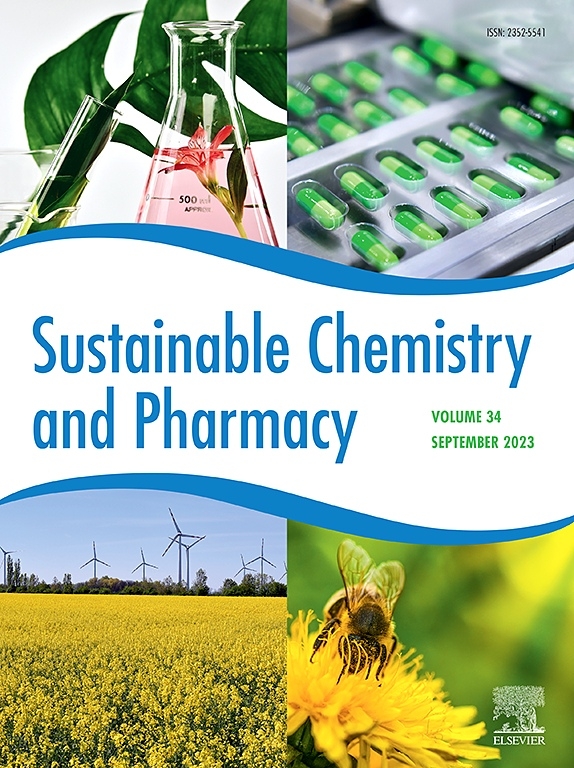天然深共熔溶剂-超声-酶联合辅助提取:黄芪多糖综合提取方法的建立及应用
IF 5.8
2区 化学
Q2 CHEMISTRY, MULTIDISCIPLINARY
引用次数: 0
摘要
黄芪多糖(Astragalus polysaccharides, APS)是黄芪(Astragalus aceus, AM)的主要活性成分之一,黄芪是东亚地区重要的药用和食用作物。为了提高黄芪多糖的提取率和质量,本研究建立了一种新颖、简洁、高效的黄芪多糖提取方法——nades -超声-酶联合辅助提取法(NUECAE)。对提取工艺进行优化,柱层析得到纯化的均质多糖。比较了传统方法(tAPS)和新方法(nAPS)获得的APS的结构特征和生物活性。结果表明,在ChCl-Lac含量为10%、料液比为1:30 (g/mL)、纤维素酶(1 U/mg)、提取时间为30 min、提取温度为75℃的条件下,黄芪多糖的提取率为14.3%,几乎是传统热水提取法(HWE, 7.6%)的两倍。从nap和tAPS中分别分离到三种均相多糖。APS的平均分子量相对较小,单糖分析表明,两种APS的单糖类型基本相同,但相对含量发生了变化。此外,nap在体外表现出稍强的抗氧化活性。与已有的方法相比,NUECAE是一种创新、高效、环保的从草药资源中提取多糖的方法。具体而言,该方法需要更低的时间、温度和能量消耗,同时可以显着提高收率并提供更高质量的多糖提取物。本文章由计算机程序翻译,如有差异,请以英文原文为准。

Natural deep eutectic solvent-ultrasonic-enzyme combination assisted extraction: Establishment of an integrated method and application on Astragalus polysaccharides
Astragalus polysaccharide (APS) is among the main active components in Astragalus membranaceus (AM), which is an important industrial crop widely used both as medicine and food in East Asia. To improve the extraction yield and quality of APS, a novel, concise and efficient extraction method, namely NaDES-Ultrasound-Enzyme combination assisted extraction (NUECAE), was established for APS in present study. The extraction parameters were optimized, and purified homogeneous polysaccharides were obtained with column chromatography. The structure features and bioactivities of APS obtained both with traditional methods (tAPS) and novel methods (nAPS) were evaluated in comparison. The results revealed that under the optimal extraction parameters: ChCl-Lac content 10 %, solid-liquid ratio 1:30 (g/mL), cellulase (1 U/mg), extraction time 30 min, and extraction temperature 75 °C, the extraction yield of APS was 14.3 %, which was almost twice as high as that of traditional heated water extraction (HWE, 7.6 %). Three homogeneous polysaccharides were isolated from nAPS and tAPS, respectively. The average molecular weight of nAPS were relatively smaller, while monosaccharide analysis showed that the monosaccharide type of both APS are almost the same, but the relative contents were altered. In addition, nAPS exhibited slightly stronger antioxidant activity in vitro. In comparison with reported methods, NUECAE is an innovative, efficient, and environmentally-friendly method for the extraction of polysaccharides from herbal resources. Specifically, the integrated method requires lower time, temperature, and energy consumption, while it can exhibit sharply higher yield and provide higher quality polysaccharide extracts.
求助全文
通过发布文献求助,成功后即可免费获取论文全文。
去求助
来源期刊

Sustainable Chemistry and Pharmacy
Environmental Science-Pollution
CiteScore
8.20
自引率
6.70%
发文量
274
审稿时长
37 days
期刊介绍:
Sustainable Chemistry and Pharmacy publishes research that is related to chemistry, pharmacy and sustainability science in a forward oriented manner. It provides a unique forum for the publication of innovative research on the intersection and overlap of chemistry and pharmacy on the one hand and sustainability on the other hand. This includes contributions related to increasing sustainability of chemistry and pharmaceutical science and industries itself as well as their products in relation to the contribution of these to sustainability itself. As an interdisciplinary and transdisciplinary journal it addresses all sustainability related issues along the life cycle of chemical and pharmaceutical products form resource related topics until the end of life of products. This includes not only natural science based approaches and issues but also from humanities, social science and economics as far as they are dealing with sustainability related to chemistry and pharmacy. Sustainable Chemistry and Pharmacy aims at bridging between disciplines as well as developing and developed countries.
 求助内容:
求助内容: 应助结果提醒方式:
应助结果提醒方式:


